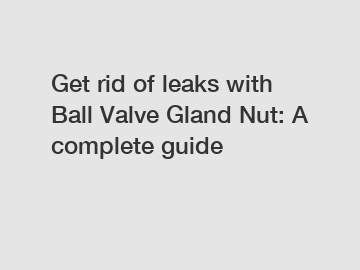Get rid of leaks with Ball Valve Gland Nut: A complete guide
You will get efficient and thoughtful service from Cencho.
Are you tired of dealing with leaks in your plumbing system? Are you constantly finding puddles of water around your pipes, causing damage to your home and potentially wasting water? If so, it may be time to invest in a ball valve gland nut to help prevent and eliminate leaks in your system.
A ball valve gland nut is a crucial component in a ball valve assembly that helps to create a tight seal and prevent leaks. By properly maintaining and replacing this nut when necessary, you can ensure that your plumbing system operates smoothly and efficiently without any pesky leaks.

In this complete guide, we will walk you through everything you need to know about ball valve gland nuts, including what they are, how they work, why leaks occur, and how to prevent and fix them. By the end of this article, you'll be equipped with the knowledge and tools to get rid of leaks once and for all.
What is a ball valve gland nut?
Before we dive into how a ball valve gland nut can help prevent leaks, let's first understand what it is and how it works. A ball valve gland nut is a small but crucial component of a ball valve assembly that helps to create a tight seal around the valve stem. This seal is essential for preventing leaks and ensuring the proper operation of the valve.
The gland nut is tightened around the valve stem to compress a packing material, usually made of rubber or Teflon, against the walls of the valve body. This packing material acts as a barrier to prevent water from leaking out of the valve when it is closed.
Why do leaks occur?
Leaks in a plumbing system can occur for a variety of reasons, but one common cause is a faulty ball valve gland nut. Over time, the packing material inside the gland nut can degrade or become damaged, leading to a weakened seal and potential leaks.
Leaks can also occur if the gland nut is not tightened properly or if the valve stem is damaged or misaligned. In some cases, leaks may be due to high water pressure or temperature, which can put additional strain on the gland nut and packing material.
How to prevent leaks with a ball valve gland nut.
Preventing leaks in your plumbing system starts with proper maintenance and care of your ball valve gland nut. Here are some tips to help you prevent leaks and keep your system running smoothly:
1. Inspect your ball valve gland nut regularly for any signs of wear or damage. Look for cracks, tears, or other visible defects in the packing material. If you notice any issues, it may be time to replace the gland nut.
2. Make sure the gland nut is tightened properly around the valve stem. Use a wrench or pliers to tighten the nut snugly but not too tight, as this can damage the packing material. Check the nut periodically to ensure it remains secure.
3. Monitor water pressure and temperature in your plumbing system. High pressure or temperature can put extra strain on the gland nut and packing material, leading to leaks. Consider installing a pressure regulator or temperature control device to help maintain optimal conditions.
4. Consider using a ball valve with a stem extension to make it easier to access and tighten the gland nut. This can help prevent leaks and make maintenance tasks more manageable.
How to fix leaks with a ball valve gland nut.
If you do encounter leaks in your plumbing system despite your best efforts, don't panic. In many cases, leaks can be easily fixed by replacing the ball valve gland nut. Here's how to do it:
1. Turn off the water supply to the affected valve and drain any remaining water from the system.
2. Use a wrench or pliers to loosen the existing gland nut and remove it from the valve stem.
3. Inspect the packing material for any signs of damage or wear. If it is damaged, replace it with a new packing material of the same size and type.
4. Slide the new packing material onto the valve stem and tighten the gland nut securely around it.
5. Turn the water supply back on and check for leaks. If the leak persists, tighten the gland nut further or consider seeking professional help.
In conclusion, a ball valve gland nut is a vital component of a plumbing system that can help prevent leaks and ensure proper operation. By understanding how it works, why leaks occur, and how to prevent and fix them, you can keep your system running smoothly and efficiently. Remember to inspect and maintain your gland nut regularly and address any leaks promptly to avoid costly damage to your home. With the right knowledge and tools, you can get rid of leaks once and for all and enjoy a leak-free plumbing system for years to come.
Please visit our website for more information on this topic.
Want more information on Oem Stainless Steel Investment Precision Castings? Feel free to contact us.



